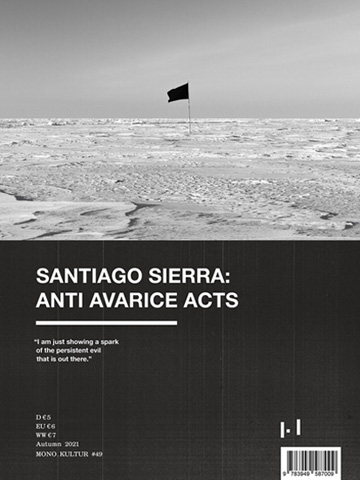Polish artist Pawe? Althamer is one of the most uncompromising and consistent artists working today and we dedicated him our mono.kultur issue #17.
For his Deutsche Guggenheim commission he has created an exhibition-in-progress that confronts visitors with a site of active production rather than passive reflection:
Almech is born out of a physical and psychic exchange between the museum and Almech, a small plastics-manufacturing firm founded and operated by the artist’s father in Weso?a, a suburb of Warsaw. Relocating a branch of this factory to Berlin, Althamer has set up machines and workers in the exhibition space, where they produce sculptural portraits of Deutsche Guggenheim, Deutsche Bank, and Guggenheim Foundation staff, as well as museum visitors. Within the museum space, facial casts are taken of portrait subjects and mounted on metal constructions. Sculptures are then ‘fleshed out’ with plastic generated by extruding machines that have been transferred from Poland to Germany. This exchange between museum and factory is formally established by new signage in each location that announces Almech in Berlin and ‘Deutsche Guggenheim’ in Weso?a.
Find more information on the exhibition here.
Pawe? Althamer on his new exhibition in Berlin:
‘For all of the participants in the Deutsche Guggenheim project, it will be a resurrection, if only for a moment. They will surrender to the ritual of making a death mask. Each will have the mask removed so that he can look at himself. It’s a form of mummification, without physical death. [...]
It will be a kind of group self-portrait. I’m posing the question of how we can broaden the self-portrait and move beyond the moment when it belongs solely to the one artist. Always working with oneself, delving only into one’s interior, is boring; sometimes you have to mix into a group or lose yourself in a collaboration, without owning any one single vision that arises from it. These activities are born of the longing for self-knowledge, to recognize oneself in this diversity, in difference. I’m quite taken by the fact that this group involved in the exhibition includes not only artists, but also office workers, and maybe even malcontents or those opposed to the project. They are all creating this self-portrait. [...]
I’m changing the principles. We’re not working within our own four walls, but trying to take part in a process, that is, we’re sculpting, touching the material, and making portraits of our- selves. The result is that roles are confused or even switched. That’s why the sculptures are on wheels: you can set them up, animate them, and put them in motion. Here we can change the way that things are arranged in our businesses, institutions, and hierarchies. For example, the CEO, like the security guard, can stand in a line and come face-to-face with someone he would never meet otherwise, and they can become friends. That disruption is interesting. When someone agrees to use his or her likeness, his or her person, it is an act of courage and commitment. Actually, by the very fact of coming into the world, we have already expressed consent to our own use.’
Read the full interview with Pawe? Althamer by Karol Sienkiewicz here.
And if you don’t have it already, get our mono.kultur issue #17 with Pawe? Althamer.
Pawe? Althamer: Almech
Exhibition dates: 28.10.2011 – 16.01.2012
Deutsche Guggenheim , Unter den Linden 13/15, 10117 Berlin
Photography: Preparations for Almech, 2011, Photo by Piotr Trzebinski, © Pawe? Althamer 2011

